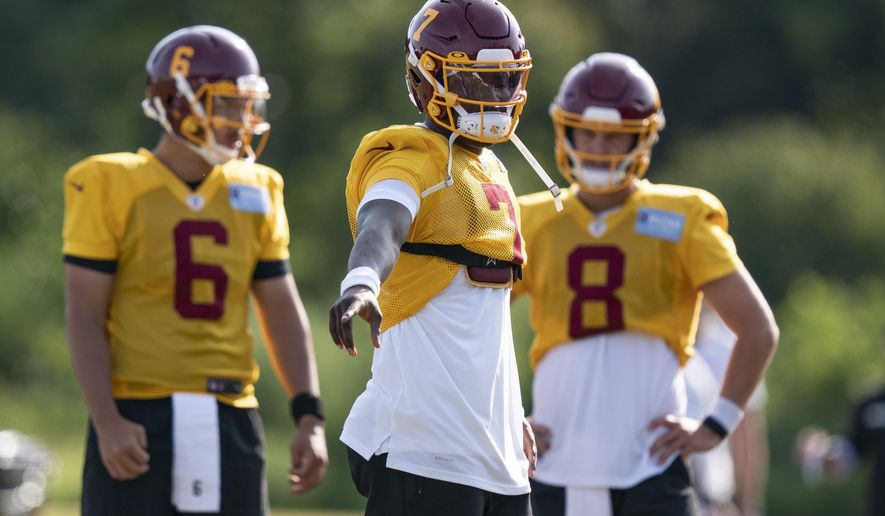ASHBURN — Urban Meyer gave Ron Rivera some advice. After Rivera took the Washington job, he reached out to the former Ohio State coach, seeking intel on Dwayne Haskins, Terry McLaurin and Chase Young. All three had played for Meyer in Columbus.
Rivera wanted insight. And Meyer delivered.
When it came to Haskins, Meyer’s suggestion was simple and straightforward: Challenge the young quarterback. Put a goal in front of Haskins and watch him set about getting the job done.
“When the young man is challenged,” Rivera said Meyer told him, “he bows up and does the things that he needs to do.”
Meyer “really gave me things that I could use,” Rivera said later.
The conversation, which Rivera revealed recently, explains much of what followed: Rivera’s initial refusal to anoint Haskins. The setting of expectations. The trade for Kyle Allen. As months passed, Haskins put in work all over the country, documented in each social media update.
When Haskins takes the field Sunday against the Philadelphia Eagles, the game will be the latest test in a pivotal year for the second-year quarterback. After eight challenging months, Haskins believes he is in a much better position than last year’s season opener, when he knew he wasn’t going to play. He’s 10 pounds lighter. He appears to not only have a command of the offense, but his teammates as well. On Wednesday, Haskins was named a team captain for the first time — a role that he didn’t even hold at Ohio State.
Looking back, Haskins, who had an inconsistent rookie year, said Rivera’s challenge was something he needed.
“I needed the extra motivation … to push myself to be that for him and for myself and for my teammates,” Haskins said. “I’ve risen to the occasion every time. It’s something that I take pride in in being accountable and knowing that when someone asks me to do something I’m going to do it the best I can and I’ll give it my all.”
Before training camp, Haskins and Rivera went months without seeing each other in person. With the coronavirus pandemic, Haskins wasn’t allowed to be at the team facility.
But Rivera still closely followed Haskins’ progress — partly with his daughter’s help. Courtney Rivera works for Washington’s social media department and so anytime Haskins would post an update, she sent it along.
As Rivera watched clips of Haskins’ training, he could tell the brief footage was more than just for show. He studied the ways Haskins perfectly placed the ball to his receivers at precisely the right time. He saw Haskins’ physical transformation, the ways his quarterback had slimmed down. Rivera said that unless Haskins was really great at editing, he couldn’t fake what was being shown.
“I had a chance to stalk him,” Rivera said.
Haskins’ relationship with Rivera stands in stark contrast to the one the quarterback had with Rivera’s predecessor, Jay Gruden. From the time Haskins was drafted 15th overall, reports swirled that Gruden, in a make-or-break year, didn’t want the Ohio State product, who was seen as a project after starting just one year with the Buckeyes. Gruden had denied those claims, but the tension still lingered — even after the coach was fired in October.
Quincy Avery, Haskins’ private quarterbacks coach in the offseason, said the dynamic throughout Haskins’ rookie year made for a tough situation. “I think everybody knew,” Avery said. “He handled it as well as he could. … People discount how hard that would be for a 20-something-year-old.”
Avery has worked with Haskins for the past few years. But this offseason, he said saw a quarterback who realized the realities of the work it takes to become a successful starter in the NFL. It wasn’t that Haskins wasn’t working hard before, he said, but there was a better understanding of the responsibilities required.
Avery also understood, like Rivera and Meyer, the need to incorporate new methods of pushing Haskins. Avery said Haskins is the type of person whose intelligence makes it so that he’s always stimulated. “He’s so smart,” he said.
One of the ways Avery said he tries to keep Haskins and the rest of his quarterbacks sharp is by incorporating chess into workouts.
Yes, chess.
Between drills, Haskins would go in front of a station that had an iPad. Playing with chess pro Seth Makowsky, the quarterback would see the board over FaceTime and then give instructions for what the next move should be.
Haskins, who began playing chess in college and loves it, said it’s a lot like playing quarterback.
“You don’t want to be in a position where you’re caught reacting,” Haskins said. “You kind of just want to be able to anticipate what’s going on and just knowing if I get this, like I said earlier I know I have this, this, this to retaliate to or go to without having much thought or effort about it. Just having it already trained in my head.”
So, how is he as a chess player?
Avery pauses.
“He’s learning,” Avery said with a laugh.
On the field, Avery spent much of the time working with Haskins on his mental process. Understanding concepts has never been the problem, he said. But when Avery examined how Haskins could improve, he identified that Haskins needed to be faster at identifying what the defense was presenting at the line of scrimmage. And then be prepared for it.
Against the Eagles, Haskins will have to be ready for the obstacles Philadelphia presents — namely the team’s fearsome defensive line. But more so, there will be moments that will call for Haskins to lead.
It will put those months of training to the test.
“I’m looking forward to leading these men,” Haskins said.
• Matthew Paras can be reached at mparas@washingtontimes.com.




Please read our comment policy before commenting.